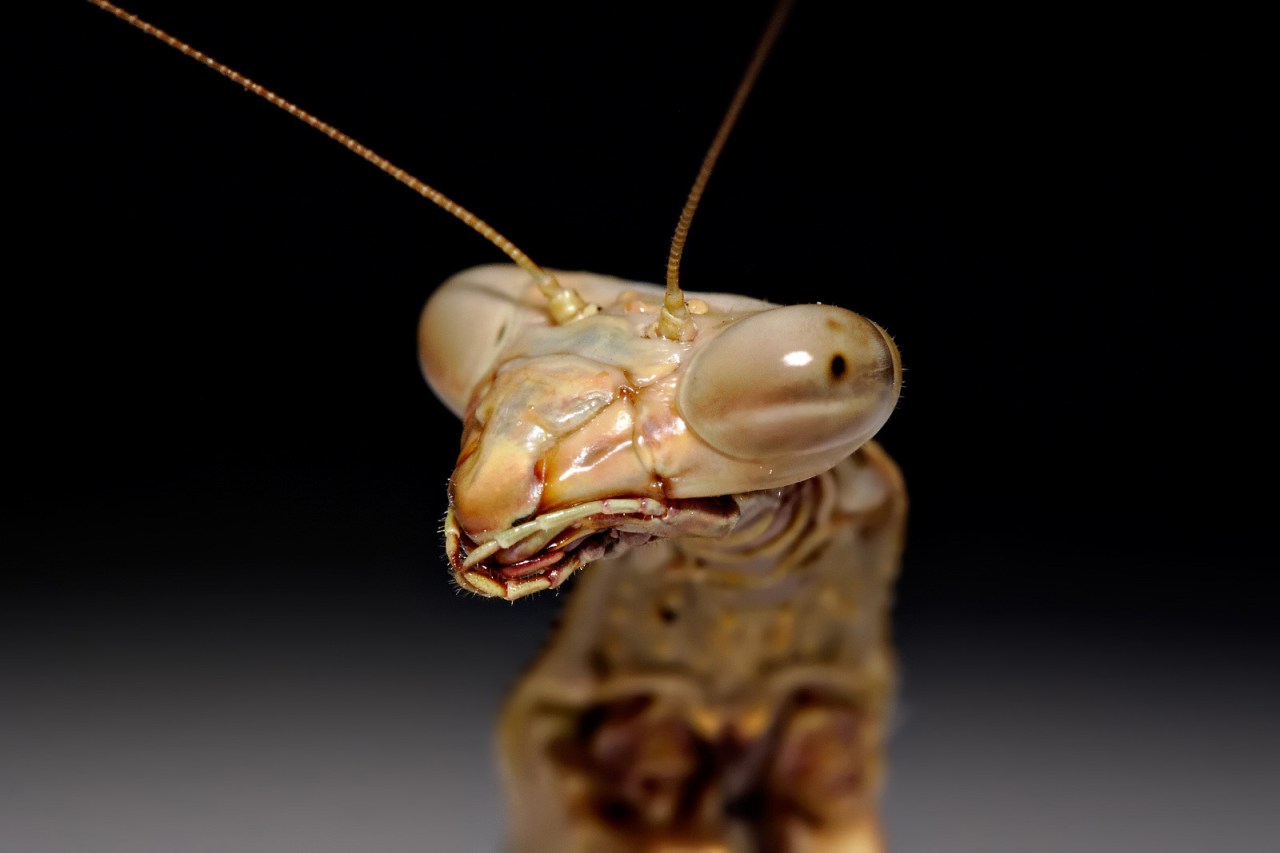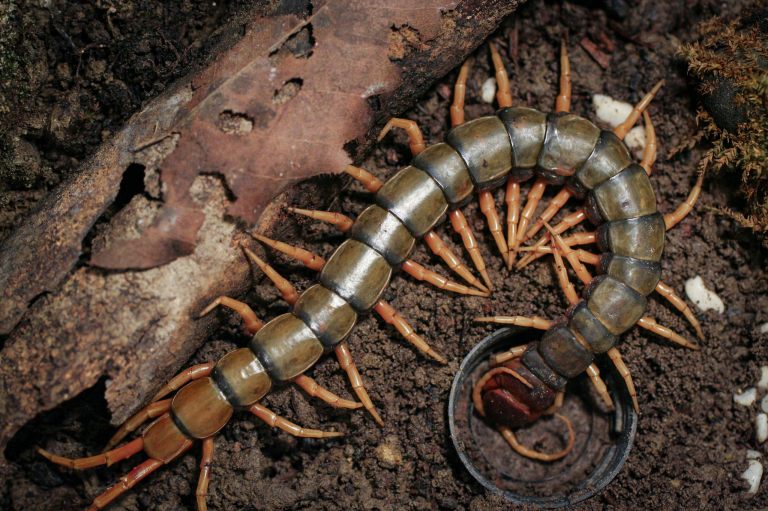Nightmares With Many Legs: Centipedes Among Us
By Mark Dery

“We’re all black centipedes at heart,” the novelist and mordant social satirist William S. Burroughs once observed. Clearly not a people person.
As for what a centipede is at heart—or would be, if it had a heart, instead of a long tube running the length of its body—who knows? The inner lives of centipedes, if there is such a thing—a doubtful proposition—are inscrutable to cognitive ethologists, scientists who study awareness and intention in animal behavior. The very idea of a centipede with a mental life takes anthropomorphization to Pixar extremes. And if there’s any creature that defies anthropomorphization, it’s the centipede, whose anatomy and behavior (and primitive cognitive flickerings, such as they are) are untranslatable into any human equivalent.
Which doesn’t stop R.F. Lawrence, in The Centipedes and Millipedes of Southern Africa, from making a game attempt. Conceding that, yes, “the centipede is a blood-thirsty and destructive creature with no beneficial or even useful qualities that we can discover,” he insists, not entirely convincingly, that “the astonishing care with which the mother centipede tends her young does to a certain extent bridge the gulf that separates us from such a totally different order of life.” Discreetly omitted is any mention of the mother centipede’s inevitable tendency, when she and her brood are disturbed by, say, a human interloper with a collection tray, to devour her young. All of them. In truth, the gulf is unbridgeable; centipedes are a different order of life altogether, as many light years from us as Burroughs’s man-eating Venusian parasites.

Unlike, say, Praying Mantises, centipedes are all eyes without a face, and dead eyes at that, set in a dead mask, expressionless as Darth Vader’s. A centipede’s head, like that of many arthropods, is sheathed in exoskeletal armor, a layer of non-living chitinous material known in the centipede’s case as cuticle; as the animal grows, it must periodically shed its shell through ecdysis, or molting, and grow a new one. For this reason, arthropods are incapable of facial expressions. In this regard, the mantis and the centipede are alike. Even so, the mantis’s large, forward-mounted eyes with pupils (pseudopupils, to be exact) invite us to anthropomorphize their owner. Its ability to focus its binocular gaze makes the experience of being looked in the eye by a mantis unsettling; the sense of an active intelligence behind those eyes is uncanny. By contrast, most centipedes have ocelli, the simple eyes common among invertebrates—dark, unblinking dots with no more life in them than a jet button. Look into them, and all you see is a mindless hunger, a never-ending search for prey, the periodic need to eliminate, to procreate—419 million years’ worth of evolutionary programming.

And then there’s the question of face: the mantis’s big, liquid eyes and triangular head make it look weirdly humanoid, or at least enough like the archetypal alien abductors popularized by Whitley Strieber’s Communion to correspond to a reassuringly familiar visual cliché for the humanoid (if not human) Other. Its ability to swivel its head—a prodigious feat for an arthropod, made possible by the flexibly articulated section of its prothorax that serves as a neck—heightens our impression of looking at a little green man. Centipede “faces,” on the other hand, are barely mappable onto our preconceptions of what a face looks like. Magnified, Scutigera coleoptrata (the most common of the house centipedes, in the States) looks, with its bulbous compound eyes and characteristic dark markings right about where a cat’s nose would be, more or less in the shape of a cat’s nose, a bit like a disgruntled cartoon feline—Felix the Cat in high dudgeon. (The markings even suggest a philtrum, the crease that divides a cat’s upper lip.) But the average centipede, when he looks in the mirror, sees a flattened “head capsule” dominated by an impressive pair of antennae, segmented and curled at the ends like a silent-movie villain’s moustache. Up close, the creature’s maw is a fearsome mesh of mouthparts from Hell: the mandibles and first and second maxillae. The incurving, wicked-looking forcipules, or poison claws, complete the picture, which, not to rub it in, isn’t pretty.
Centipedes come in four models, all of them venomous. The order Geophilomorpha comprises the long, wormlike, eyeless centipedes, blind burrowers in the earth that have 31 to 181 pairs of legs; Scolopendromorpha, the big tropical and subtropical species with 21 or 23 leg pairs mentioned earlier; Lithobiomorpha, the short-bodied species with 15 pairs of legs that, being “cryptozoic,” as biologists like to say, conceal themselves under stones or bark or the like; and Scutigeromorpha, the house centipedes, “creatures of the damp” (C.L. Marlatt) whose 15 pairs of alarmingly long, whiskery looking legs and even longer, whiplike antennae make their one-inch bodies look enormous, especially when they’re racing toward you at 16 inches a second (the land speed record for myriapods), a habit that has made them the bane of homeowners everywhere. Noting the animal’s “altogether too friendly manner of approaching people,” Marlatt, an entomologist with the United States Department of Agriculture, describes the battle of the species in a 1902 government publication, The House Centipede (Scutigera forceps):
It may often be seen darting across floors with very great speed, occasionally stopping suddenly and remaining absolutely motionless, presently to resume its rapid movements, often darting directly at inmates of the house, particularly women, evidently with a desire to conceal itself beneath their dresses, and thus creating much consternation.
All four orders are venomous. Centipede venom is poorly understood, but we do know that it’s a witches’ brew of myotoxic, cardiotoxic, and neurotoxic chemicals, and that it contains 5-hydroxytryptamine (serotonin), which quickly immobilizes prey. Centipede venom attacks the central nervous system of envenomated animals, causing, as J.G.E. Lewis notes in The Biology of Centipedes, “respiratory acceleration, abundant sweating…loss of stability, vomiting, respiratory failures and progressive paralysis of the respiratory centers, convulsions and death.” Researchers have injected centipede venom, usually from Scolopendromorphs, into various luckless subjects, says Lewis: rabbits (“paralysis in the hind leg, edema, then an abscess and death after 17 days”), a white rat (“paralysis in the hind leg but eventually recovered completely”), even crayfish (“reactions similar to intoxication…a short period of agitation followed by violent contraction and cessation of respiratory movements followed by death”). (What, by the way, does an intoxicated crayfish act like?)
Contrary to folklore, centipedes are not, barring rare exceptions, lethal to humans. Scutigeromorphs’ forcipules are, as a rule, too tiny to pierce human skin; in the few documented examples of them having managed to do so, their sting was reportedly no worse than a bee’s. Envenomation by the much-larger scolopendromorphs is, predictably, much nastier, though rarely fatal; as of 2006, the medical literature documented only three deaths, worldwide, caused by centipede poisoning. Typically, patients complain of pain, sometimes severe, accompanied in some cases by headache, dizziness, and vomiting. The site of envenomation usually swells and reddens and on occasion becomes ulcerated and necrotic.
Still, a healthy young Turkish man with no risk factors for coronary artery disease experienced acute myocardial infarction (heart attack, by any other name) after being bitten on the leg by a scolopendrid. A 1985 issue of The Western Journal of Medicine records the case of an obese woman in an Arizona mining town who experienced renal failure after being bitten, on one foot, by the giant desert centipede, Scolopendra heros. Hemodialysis and debridement (surgical removal of dead or diseased tissues, in this case necrotic muscle) saved her life, but four weeks after she’d been bitten, her recovery was “still incomplete,” her doctors reported. “Generally, the scolopendrids have been described as relatively harmless to humans,” they note. They’re hard-pressed to describe “significant morbidity” leading to myonecrosis (death of muscle tissue) and acute renal failure—a “life-threatening condition that the patient fortunately survived”—as “relatively harmless.” Thus their cautionary note: “Physicians practicing in the areas in which the giant desert centipede is found should be alert to the possible morbidity and mortality that can result from envenomation, which heretofore has not been widely appreciated.”

Of course, such cases are uncommon. Nevertheless, the legend of the centipede’s death-dealing sting is impervious to fact. Tradition has it that even the arthropod’s touch is life-threatening. William J. Baerg, the esteemed head of the Department of Entomology at the University of Arkansas in Fayetteville, relates the story of a Confederate officer who, tickled by the creepy-crawly sensation of something walking across his chest, woke to find a large centipede on him. Reportedly, deep red spots marked the animal’s trail. After two pain-racked days, the man succumbed. The victim’s death agonies, an eyewitness said, were frightful to behold. (Gordon Grice, the nature writer, suspects a black widow was the culprit.)
Baerg was a character. He kept his garden well-stocked with a frolicsome population of tarantulas; protected his flock from meddlesome locals with a stone wall whose wrought-iron gate depicted an orb web with a spider in it; and once volunteered, at the age of 85, to be a test subject for research into the toxicity of the yellow sac spider, whose venom is purportedly as nasty as that of the dreaded brown recluse. (The researchers politely declined his offer. Chances are they didn’t want to go down in the annals of arachnology as Baerg’s unwitting executioners.)
Baerg was fond of guinea-pigging himself to debunk folk wisdom about the toxicity of arachnids and arthropods: he induced a tarantula to bite him—no worse than a bee sting, he declared—and in 1923 famously provoked a black widow into sinking its fangs into his finger, an act of scientific martyrdom for which he was rewarded with three days of agonizing pain, fastidiously recorded by the subject himself between bouts of delirium and bizarre nightmares.
The question of the widow’s venomousness settled to his satisfaction, Baerg turned his attentions to the centipede. “The centipedes, especially the larger species, are, according to popular opinion, dangerously poisonous,” he wrote, in “The Effect of the Venom of Some Supposedly Poisonous Arthropods” (1924). “A very common belief is that if the victim does not die, the flesh will rot and drop off from the region where the bite took place.” Baerg was doubtful. He rounded up some Scolopendromorphs and the odd Lithobius mordax Koch, and coaxed the beasts, one by one, into latching onto his finger. The results were underwhelming: Lithobius couldn’t even manage to penetrate the skin on his pinky; the worst of the scolopendrid bites produced a sharp pain, like a needle-prick, which, three hours later, had vanished entirely.
Still, reports of the centipede’s virulence persist, nourished by age-old lore and superstition. The naturalist Charles Owen maligned the animal in his Essay Towards a Natural History of Serpents (1752) as “a little venomous worm,” which, “when it wounds any, there follows a blueness about the affected part and an itch all over the body like that caused by nettles.”
Its weapons of mischief are much the same with those of the spider, only larger; its bite is very tormenting, and produces not only pruriginous pain in the flesh, but very often distraction of the mind. These little creatures make but a mean figure in the ranks of animals, yet have been terrible in their exploits, particularly in driving people out of their country. Thus the people of Rhytium, a city of Crete, were constrained to leave their quarters for them (Aelian, lib. XV., cap. 26).
Silas Claiborne Turnbo, best-known for his collections of Ozark folklore, legends, and superstitions, gathered around the turn of the 19th century, recounts the agonies of a Missouri child laid up for a year after being bitten on the foot by a seven-inch centipede. “All the flesh surrounding the wound sloughed off,” writes Turnbo. “When the sore healed, the child remained a cripple.” The belief that a centipede bite makes the flesh fall off the victim’s bones was established fact among rural folk, as was the notion, recorded by Vance Randolph in Ozark Superstitions (1947), that a centipede will attempt to count the teeth of any child it encounters; if it manages to do so, the child will surely die in a matter of weeks. Another folklorist reported the conviction, in some quarters, that if a centipede so much as saw your teeth, they would rot down to stumps. Randolph witnessed Ozark children clamping their jaws tight shut or clapping their hands over their mouths in the presence of a centipede.
J. L. Cloudsley-Thompson, in Spiders, Scorpions, Centipedes and Mites: The Ecology and Natural History of Woodlice, “Myriapods” and Arachnids (1958), repeats the claim that a centipede’s feet, on human skin, produce ghastly stigmata—an assertion that has all the marks of a tall tale.
In southern California the large greenish Scolopendra heros is greatly feared, not only on account of its poisonous bite but because it also produces a reddish streak where it has crawled upon the body. Like many other tropical and subtropical Scolopendromorpha, it makes tiny incisions with its numerous feet. In themselves these are trifling, but when alarmed the centipede drops into each incision some kind of venom that causes intense irritation so that the affected part becomes inflamed and the two rows of punctures show white against the flesh.
Improbable as it sounds, this isn’t beyond the realm of possibility: some species of centipedes possess glands, usually on their last few leg pairs, that produce repugnatorial fluid—noxious stuff whose primary ingredient is hydrocyanic acid. Repulsive and in some cases fatal to the animal’s predators, it could easily irritate human skin.
Weirder still, and more horrifying by far, are the cases Cloudsley-Thompson mentions of “pseudoparasitism” in which centipedes have been discovered “living in the nasal sinus or alimentary canal of man, into which they have become accidentally introduced. On occasions they have been vomited up by patients who alleged that the animals were breeding inside them.” So gothically over-the-top they wouldn’t be out of place in those Tales From the Crypt comics that gave child psychologists fits in the ‘50s, stories of centipedes insinuating themselves into body cavities are well-documented, incredibly. (Stories of centipedes breeding inside the human body, not so much.) “Numerous instances are on record in which the centipedes have lodged in the nose or its adjacent sinuses for months or even years, no less than 10 such cases having been collected by Teidemann,” Sir Morell Mackenzie confirms, in his Manual of Diseases of the Throat and Nose (1884). An 1898 issue of the Journal of Laryngology, Rhinology, and Otology includes a Dutch doctor’s mind-curdling account of a young woman who complained of a chronic headache, which seemed to be centered above her right eye, and who suffered from “a slight muco-purulent secretion of the right side of her nose”—the aftereffects, she thought, of a cold she’d weathered. The doctor prescribed menthol with boric acid “to snuff up.” The lady dutifully snuffed up; heavy sneezing ensued. In her handkerchief she discovered “a small insect, still alive,” which she had the presence of mind to preserve in brandy for examination by the doctor. It was, of course, a “chilopode” (centipede), about seven millimeters long. ![]()



